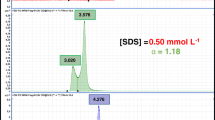Abstract
A sensitive yet robust analytical method is presented for the simultaneous determination of 12 human pharmaceuticals (valproic acid, phenytoin, ibuprofen, gabapentin, acetaminophen, gemfibrozil, naproxen, ketoprofen, secobarbital, phenobarbital, 5-fluorouracil, and diclofenac) and 6 antiseptics (biosol, biphenylol, p-chloro-m-cresol, p-chloro-m-xylenol, chlorophene, and triclosan). The method employs solid-phase extraction (SPE) followed by a novel pentafluorobenzylation using a mixture of acetontrile/water (1/1, v/v). The method is simple to perform (derivatization can be completed in a single test tube) and eliminates the need for any solvent/SPE cartridge drying or blow-down. It affords excellent resolution, high sensitivity and reproducibility, and freedom from interference even for matrices as complex as untreated sewage. The method was applied to the analysis of sewage samples using 15 isotopically labeled surrogates, which resulted in the detection of 10 of the 12 pharmaceuticals and all of the antiseptics sought. Ten of 15 surrogates were synthesized from pure analytes by a simple H-D exchange reaction employing D2O and D2SO4. Measured recoveries were sensitive to matrix effects and varied substantially among analytes, indicative of the limitations associated with using a single surrogate standard.


Similar content being viewed by others
References
Daughton CG, Ternes TA (1999) Pharmaceuticals and personal care products in the environment: agents of subtle change. Environ Health Perspect 107:907–938
Heberer T (2002) Occurrence, fate, and removal of pharmaceutical residues in the aquatic environment: a review of recent research data. Toxicol Lett 131:5–17
Nikolaou A, Meric S, Fatta D (2007) Occurrence patterns of pharmaceuticals in water and wastewater environments. Anal Bioanal Chem 387:1225–1234
Barnes KK, Kolpin DW, Furlong ET, Zaugg SD, Meyer MT, Barber LB (2008) A national reconnaissance of pharmaceuticals and other organic wastewater contaminants in the United States—I) groundwater. Sci Total Environ 402:192–200
Focazio MJ, Kolpin DW, Barnes KK, Furlong ET, Meyer MT, Zaugg SD, Barber LB, Thurman ME (2008) A national reconnaissance for pharmaceuticals and other organic wastewater contaminants in the United States—II) untreated drinking water sources. Sci Total Environ 402:201–216
Miège C, Choubert JM, Ribeiro L, Eusèbe M, Coquery M (2009) Fate of pharmaceuticals and personal care products in wastewater treatment plants—conception of a database and first results. Environ Pollut 157:1721–1726
Richardson SD (2010) environmental mass spectrometry: emerging contaminants and current issues. Anal Chem 82:4742–4774
Stackelberg PE, Furlong ET, Meyer MT, Zaugg SD, Henderson AK, Reissman DB (2004) Persistence of pharmaceutical compounds and other organic wastewater contaminants in a conventional drinking-water treatment plant. Sci Total Environ 329:99–113
Jobling S, Tyler CR (2006) Introduction: the ecological relevance of chemically induced endocrine disruption in wildlife environ. Health Perspect 114(S-1):7–8
De Guidi G, Ragusa S, Cambria MT, Belvedere A, Catalfo A, Cambria A (2005) Photosensitizing effect of some nonsteroidal antiinflammatory drugs on natural and artificial membranes: dependence on phospholipid composition. Chemical Research in Toxicology Chem Res Toxicol 18:204–212
Oaks JL, Gilbert M, Virani MZ, Watson RT, Meteyer CU, Rideout BA, Shivaprasad HL, Ahmed S, Chaudhry MJI, Arshad M, Mahmood S, Ali A, Khan AA (2004) Diclofenac residues as the cause of vulture population decline in Pakistan. Nature 427:630–633
Henry TB, Kwon JW, Armbrust KL, Black MC (2004) Acute and chronic toxicity of five selective serotonin reuptake inhibitors in Ceriodaphnia dubia. Environ Toxicol Chem 23:2229–2233
Crane M, Watts C, Boucard T (2006) Chronic aquatic environmental risks from exposure to human pharmaceuticals. Sci Total Environ 367:23–41
Pomati F, Castiglioni S, Zuccato E, Fanelli R, Vigetti D, Rossetti C, Calamari D (2006) Effects of environmental contamination by therapeutic drugs on human embryonic cells. Environ Sci Technol 40:2442–2447
Yang LH, Ying GG, Su HC, Stauber JL, Adams MS, Binet MT (2008) Growth-inhibiting effects of 12 antibacterial agents and their mixtures on the freshwater microalga Pseudokirchneriella subcapitata. Environ Toxicol Chem 27:1201–1208
Milne GWA (ed) (2002) Drugs: synonyms and properties, 2nd edn. Wiley, Hoboken
Buchberger WW (2011) Current approaches to trace analysis of pharmaceuticals and personal care products in the environment. J Chromatography A 1218:603–618
Richardson SD, Ternes TA (2005) Water analysis: emerging contaminants and current issues. Anal Chem 77:3807–3838
Ollers S, Singer HP, Fassler P, Muller SR (2001) Simultaneous quantification of neutral and acidic pharmaceuticals and pesticides at the low-ng/L level in surface and waste water. J Chromatogr A 911:225–234
Verenitch SS, Lowe C, Mazumder A (2006) Determination of acidic drugs and caffeine in municipal wastewaters and receiving waters by gas chromatography–ion trap tandem mass spectrometry. J Chromatogr A 1116:193
Diaz-Cruz MS, de Alda MJL, Lopez R, Barcelo D (2003) Determination of estrogens and progestogens by mass spectrometric techniques (GC/MS, LC/MS and LC/MS/MS). Mass Spectrom 38:917–923
Huggett DB, Khan IA, Foran CM, Schlenk D (2003) Determination of beta-adrenergic receptor blocking pharmaceuticals in United States wastewater effluent. Environ Pollut 121:199–205
Bisceglia KJ, Yu JT, Coelhan M, Bouwer EJ, Roberts AL (2010) Trace determination of pharmaceuticals and other wastewater-derived micropollutants by solid phase extraction and gas chromatography/mass spectrometry. J Chromatogr A 1217:558–564
Koutsouba V, Heberer T, Fuhrmann B, Schmidt-Baumler K, Tsipi D, Hiskia A (2003) Determination of polar pharmaceuticals in sewage water of Greece by gas chromatography–mass spectrometry. Chemosphere 51:69–75
Boucharat C, Desauziers V, Le Cloirec P (1998) Experimental design for the study of two derivatization procedures for simultaneous GC analysis of acidic herbicides and water chlorination by-products. Talanta 47:311–323
Reddersen K, Heberer T (2003) Multi-compound methods for the detection of pharmaceutical residues in various waters applying solid phase extraction (SPE) and gas chromatography with mass spectrometric (GC-MS) detection. J Sep Sci 26:15–16
Bowers GN Jr, Fassett JD, White EV (1993) Isotope dilution mass spectrometry and the National Reference System. Anal Chem 65:475R–479R
López-Serna R, Pérez S, Ginebreda A, Petrovic M, Barceló D (2010) Fully automated determination of 74 pharmaceuticals in environmental and waste Waters by online solid phase extraction-liquid chromatography-electrospray-tandem mass spectrometry. Talanta 83:410–424
Hao C, Zhao X, Tabe S, Yang P (2008) Optimization of a multiresidual method for the determination of waterborne emerging organic pollutants using solid-phase extraction and liquid chromatography/tandem mass spectrometry and isotope dilution mass spectrometry. Environ Sci Technol 42:4068–4075
Vanderford BJ, Snyder SA (2006) Analysis of pharmaceuticals in water by isotope dilution liquid chromatography/tandem mass spectrometry. Environ Sci Technol 40:7312–7320
de Lima Gomes PC, Bbarletta JY, NNazaria CE, Santos-Neto AJ, Von Wolfff MA, Coneglian CM, Umbuzeiro GA, Lancas FM (2011) Optimization of in situ derivatization SPME by experimental design for GC-MS multi-residue analysis of pharmaceutical drugs in wastewater. J Sep Sci 34:436–445
Coelhan M, Bromig KH, Glas K, Roberts AL (2006) Determination and levels of the biocide ortho-phenylphenol in canned beers from different countries. J Agr Food Chem 54:5731–5735
Bisceglia KJ (2010) Ph.D. dissertation, Johns Hopkins University, Baltimore, USA
Chan KK, Pang KS (1982) Synthesis of singly deuterium-, tritium-, and carbon-14- and doubly labeled acetaminophen, phenacetin, and p-acetanisidine. J Label Compd Radiopharm 19:321–329
Winslow SD, Prakash B, Domino MM, Pepich BV, Munch DJ (2000) Method 526 determination of selected semivolatile organic compounds in drinking water by solid phase extraction and capillary column gas chromatography/mass spectrometry (GC/MS). National Exposure Research Laboratory Office of Research and Development, U.S. Environmental Protection Agency, Cincinnati, Ohio.
Khan SJ, Ongerth JE (2002) Estimation of pharmaceutical residues in primary and secondary sewage sludge based on quantities of use and fugacity modeling. Water Sci Tech 46:105
Yu JT, Bouwer EJ, Coelhan M (2006) Occurrence and biodegradability studies of selected pharmaceuticals and personal care products in sewage effluent. Agr Water Manage 86:72–80
Acknowledgments
We thank Padma T. Venkatraman and Michael Blumenfeld for their initial work on pentafluorobenzylation. Funding for this research was provided by agreement number R82900401-0 from the US Environmental Protection Agency, Science to Achieve Results (STAR) program. Although the research described in the article has been funded wholly by the EPA’s STAR program, it has not been subjected to any EPA review and therefore does not necessarily reflect the views of the Agency, and no official endorsement should be inferred.
Author information
Authors and Affiliations
Corresponding author
Electronic supplementary material
Below is the link to the electronic supplementary material.
Fig. S1
(PDF 196 kb)
Rights and permissions
About this article
Cite this article
Yu, J.T., Bisceglia, K.J., Bouwer, E.J. et al. Determination of pharmaceuticals and antiseptics in water by solid-phase extraction and gas chromatography/mass spectrometry: analysis via pentafluorobenzylation and stable isotope dilution. Anal Bioanal Chem 403, 583–591 (2012). https://doi.org/10.1007/s00216-012-5846-5
Received:
Revised:
Accepted:
Published:
Issue Date:
DOI: https://doi.org/10.1007/s00216-012-5846-5




